The quest for truth
Astrology was practised by the rishis (sages) in ancient times. However, humanity has lost that precious art through the ages, and what goes around as astrology nowadays is but a pale shadow of what our ancestors knew then. As a result, in my endeavour to learn authentic astrology, I had to overcome a few misconceptions on what is considered authentic.
Table of Contents
Are the classical astrology books authentic?
The classical astrology books we have now have all been penned down after the start of Kali yuga. For example, Brihat Jataka is said to have been written about 2000 yrs back, and all the other books available now were written after Brihat Jataka. Moreover, the authenticity of the versions of Brhat Parasara Hora Sastra we have now is debatable. A profound discussion on this topic is available here.
Brihat Jataka
I read Brhat Jataka so as to learn astrology in its purest form as expounded by the sages. But, I felt wanting for more and that the book was incomplete. I don’t intend to say that I mastered that book, but the book does not discuss even some basic aspects of astrology like the rules about rahu and ketu; about 6th, 8th, and 12th houses being bad; etc.
No agreed-upon rules in Vedic astrology
To add to the confusion, no two books agreed on the astrological rules, and applying those contrasting rules did not produce good results. Certainly, I am not a master of astrology, agreed. But, even the masters cannot understand the basis of the predictions in nadi astrology and Saptarishi Nadi.
Saptarishi Nadi
To clarify, those who have consulted nadi astrology will realize the precision of the past-life predictions in those palm leaves; therefore, a science capable of such predictions existed/exists. In fact, we do have the work of saptarishis themselves in the Saptarishi Nadi series.
Saptarishi Nadi is a collection of books containing discussions of horoscopes by the seven sages (saptarishis) and the consort of Lord Siva, Devi Parvati, herself. It is written in poetic form in the Tamil language. These books were compiled from palm manuscripts found in various parts of Tamilnadu, India, and published by the Government Oriental Manuscripts Library, Madras. Most importantly, they are a treasure house for those who want to analyze the predictions of the horoscopes by the ancient sages. I have discussed at length about this collection in the Saptarishi Nadi section. I have compiled the portions where the saptarishis put forth their arguments in favor of/against some of their predictions in the form of an eBook titled, “Elucidation of astrological predictions by saptarishis: Saptarishi Nadi, Aries ascendant collection.”
The most intriguing aspect of Saptarishi Nadi is that the verses indicate the planetary position at the time of birth. The saptarishis also elaborate on their predictions and elucidate the various conflicting rules, which throw much light on the authentic rules of astrology.
Saptarishis used tropical zodiac
In the course of my quest for authentic astrology, a tectonic realization occurred: I learned that the saptarishis used a tropical zodiac with sidereal nakshatras, as opposed to a sidereal zodiac. To clarify, traditional Indian astrologers nowadays use sidereal zodiac. I have discussed at length the evidence that the saptarishis used a tropical zodiac in my article here. Specifically, manuscript evidence for the use of tropical zodiac by the saptarishis is also available now.
Tropical zodiac vs sidereal zodiac
To understand the impact of using a tropical zodiac versus sidereal zodiac, let’s compare the charts for two countries that obtained independence at the same time—India and Pakistan.
Chart using sidereal zodiac for India and Pakistan
Both India and Pakistan obtained independence on August 15, 1947, at the stroke of midnight. The horoscopes for India and Pakistan generated using sidereal zodiac (traditional Lahiri ayanamsa) are given below:
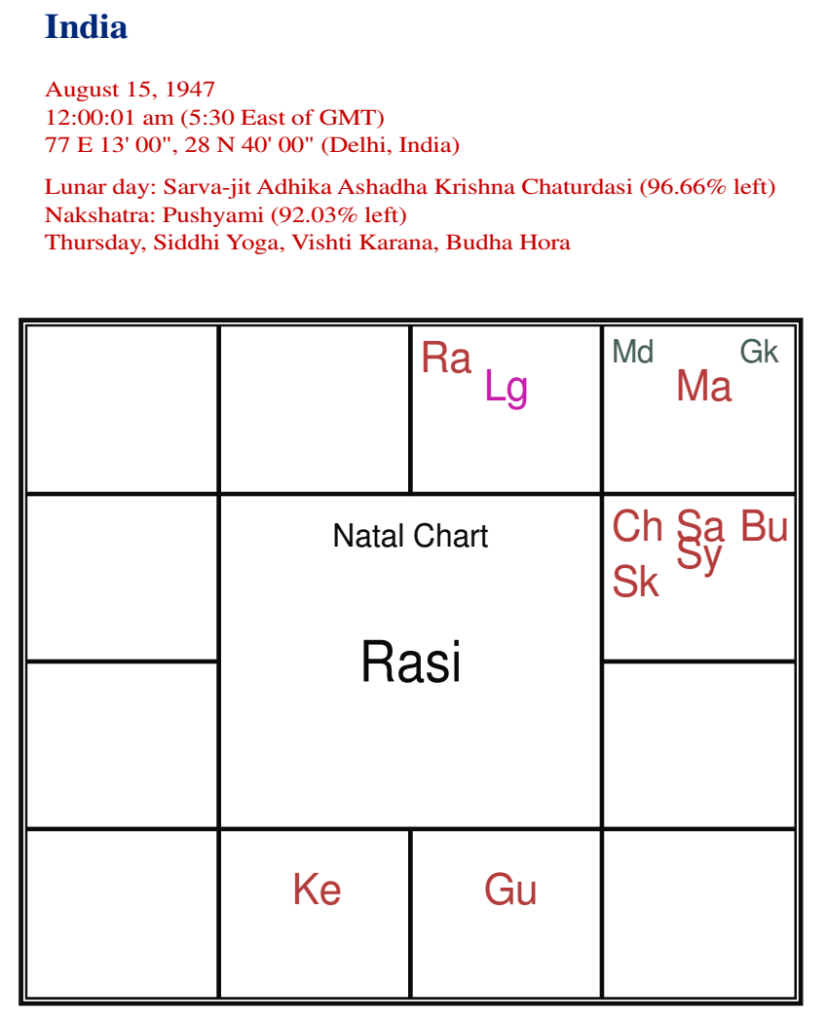
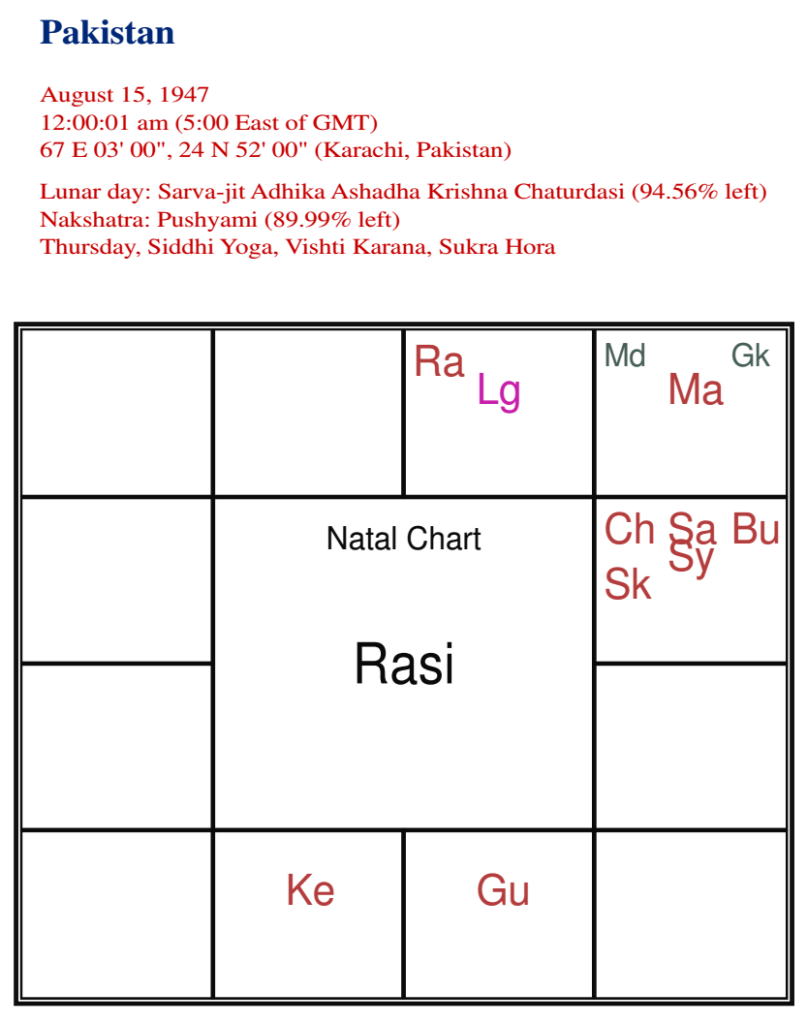
We see that the ascendants are the same for both countries. In fact, the horoscopes are the same for both countries using sidereal zodiac. However, we know that the two countries have very different characters, standing in the world stage, and growth trajectories.
Although Pakistan now celebrates its independence on the 14th of August, the Indian Independence Act 1947 recognized 15th August 1947, as the birthday of both Pakistan and India. Jinnah also declared in his first speech, “August 15 is the birthday of the independent and sovereign state of Pakistan.” Only later did Pakistan advance the Independence Day to 14th August. Therefore, for astrological predictions, 15th August should be considered as the moment of birth for Pakistan. The moment of conception cannot be changed to our whims and fancies after the fact.
The charts using tropical zodiac
Let us use tropical zodiac for calculating the birth chart of both the nations. Setting up JHora to use tropical zodiac with sidereal nakshatras has been illustrated in this post.
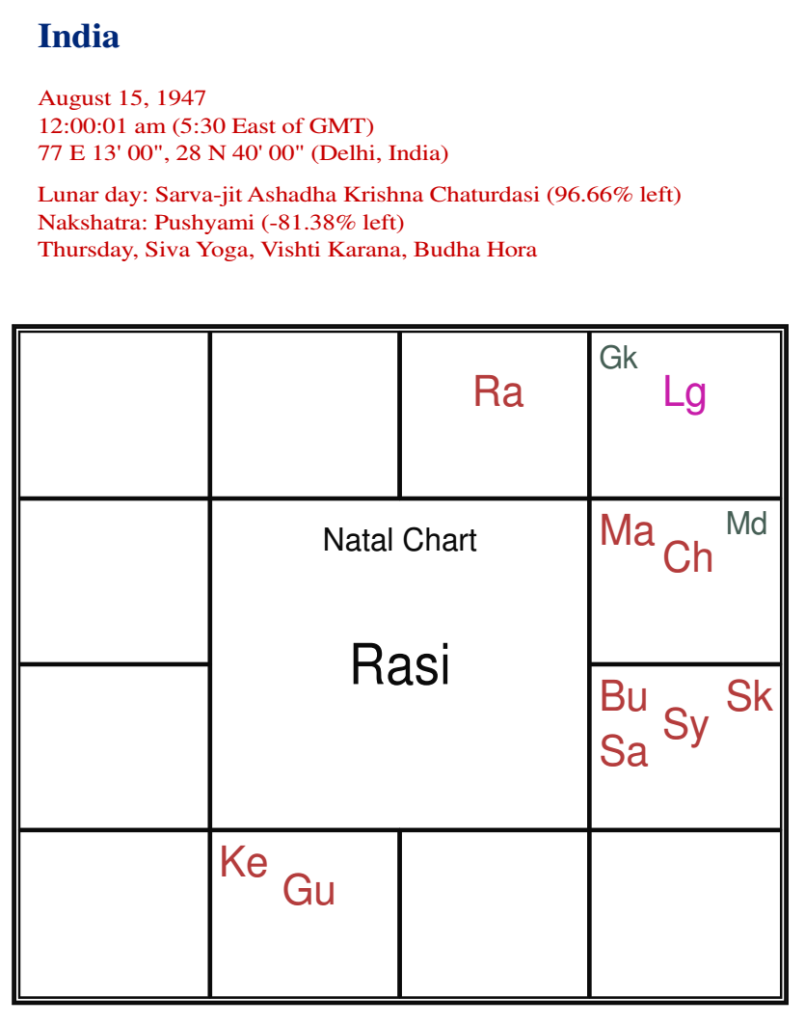
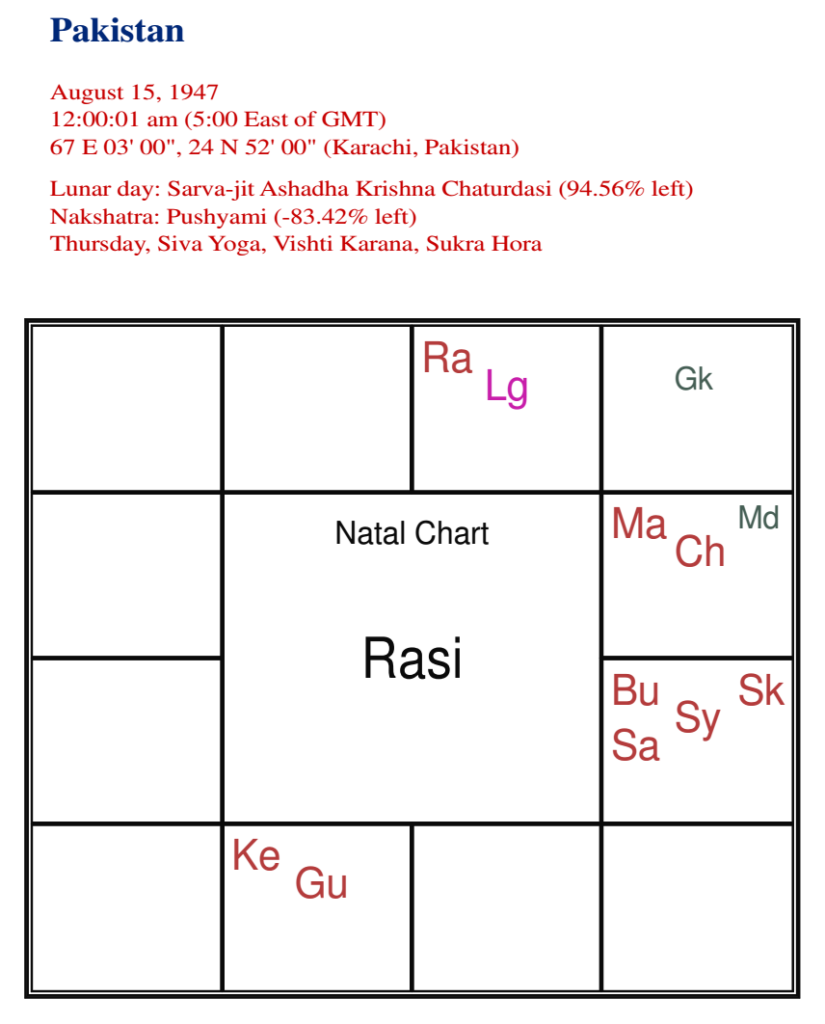
A cursory analysis shows that the ascendant is different for the two nations. The ascendant for Pakistan is the same as before (Taurus). However, the placement of the planets has changed. The ascendant for India is Gemini. The charts of India and Pakistan are different now.
One conspicuous bit of history is that Pakistan waged many wars against India and lost. The ascendant lord for Pakistan, Venus, is placed in the 4th house (Leo). Venus also happens to be the 6th lord and is strongly placed in a kendra. A strong 6th lord is not good for the analyzed entity and strengthens one’s enemies. By contrast, the 6th lord for India is Mars and is debilitated in Cancer. A native with a debilitated 6th lord overcomes her enemies.
Computation using tropical zodiac brings out the differences in the fate of the two nations, while that using a sidereal zodiac does not. Other astrologers have used a different birth time for Pakistan to circumvent this problem, which is unacceptable. The tropical zodiac clearly depicts the truth.
Try explaining the fate of India and Pakistan using sidereal zodiac. One would have to resort to complicated rules and explanations (or bend them to one’s advantage) or alter the birth time (rectification). The astrologers who used sidereal zodiac through the centuries would have tweaked the rules based on their experience to explain the life events.
Know your Vedic horoscope with tropical zodiac and sidereal nakshatras
To compute a horoscope with tropical zodiac and sidereal nakshatras for you for free, you can send me your birth particulars (date, time, and place of birth) through the contact form in the website. I will send you the basic horoscope in pdf form as soon as I find time.
To sum up
After I came across Saptarishi Nadi, I realized that the saptarishis used a tropical zodaic. However, humanity lost this knowledge during Kali yuga. Later, the traditional astrologers in India started using a sidereal zodiac. As a result, over the course of time, they would have tampered/invented the rules to suit a sidereal zodiac. Therefore, the classical astrological books we have now may not be authentic.
My blog
In my humble quest to learn authentic astrology as practised by the rishis, I have chosen to write on Saptarishi Nadi and Pulippani astrology as I find these to be authentic, unsullied by the ravages of time.
I will be writing on the authentic rules as discussed by the saptarishis in Saptarishi Nadi in my blog.
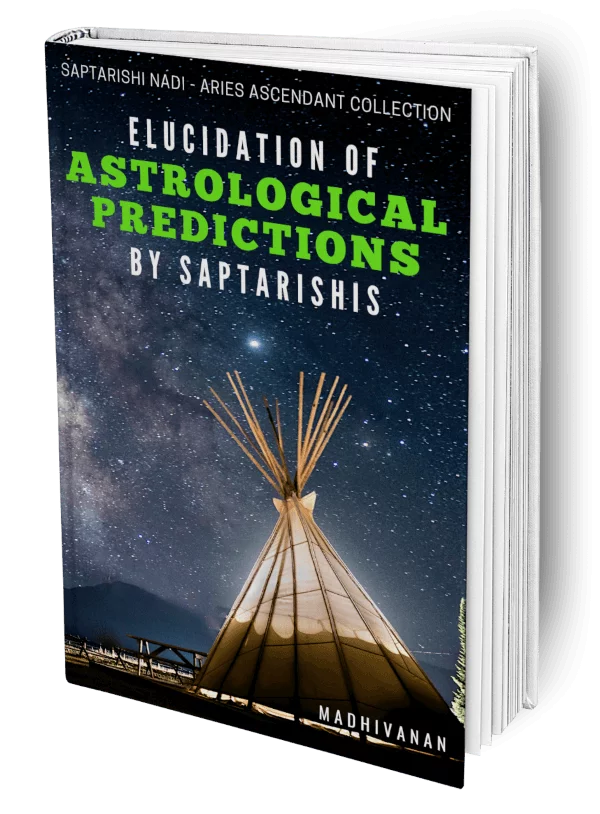
December 1, 2019 at 10:16 pm
Sir, for the zodiac we are supposed to use the Tropical Zodiac system but what about the computation of the 27 Nakshatra’s? Which Ayanamsa do you use for the 27 Nakshatra’s?
December 2, 2019 at 12:11 am
You don’t need ayanamsha for the stars. You can’t shift the stars as you like. They are there in the sky, almost fixed. We Indians use ayanamsha to shift the zodiac as per our wishes. Thankfully, we didn’t try to do that to our stars.
December 7, 2019 at 12:41 pm
Good afternoon sir, may I know whether the current transit of Jupiter is in Sagittarius Zodiac Sign or in Capricorn Zodiac Sign? Which one should we follow?
December 7, 2019 at 12:55 pm
That depends on whether you follow tropical zodiac or sidereal zodiac. Per tropical zodiac, Jupiter’s transit into Capricorn occurred on Dec 2, 2019, and it stays in Capricorn till Dec 19, 2020. I follow tropical zodiac with sidereal Nakshatras and advise others to do so too.
May 7, 2020 at 1:13 pm
Good afternoon, Dr. Madhivanan, I think Miss/Mrs. Samantha has a point, since in the post related to the Settings for the Tropical Zodiac, Sir have mentioned to the users of Jagannatha Hora software to Utilise Sidereal Zodiac for nakshatras and the nakshatra dashas when using Tropical Zodiac by fixing the Spica Star at the middle of the Chitra Nakshatra region (Definition of Nakshatra: Nak means night Kshatra means domain, Therefore Nakshatra means domain traveled by the Moon in the night-sky along the Ecliptic Circle which would be around 13 degrees and 20 minutes per day, if you times this value to the 27 divisions of the Ecliptic Circle you would get 360 degrees completing the Ecliptic Circle, this would mean that Nakshatra actually refers to the Lunar Mansions or regions traversed by the Moon per day and not the specific Stars). This remarkably explains that Sir is utilising the Lahiri Ayanamsa since it takes Spica star as a reference point in the night sky to find the start of the First Point of Sidereal Zodiac of Aries. I think this would clear Miss/Mrs. Samantha’s doubts earlier.
Now coming to the real vexing problem since the Nakshatras serve as a fundamental tool while using the Vimshottari Dasha to decide the start of an individual’s (Mahadasha) and since there are many Ayanamsa’s in existence, these Ayanamsa’s basically changes the Mahadasha accordingly to whichever Ayanamsa an individual is using. As an example an individual using Lahiri Ayanamsa and the same individual using another Ayanamsa to name one the Galactic Centre 0 degree of Sagittarius Ayanamsa would have two different Mahadasha system (Sir, you can test this out). This would confuse the person and also it would make the person question the credibility of the Ayanamsa’s used to determine that specific persons Vimshottari Dasha. The question I want to know is whether did our Saptarishis specify which Ayanamsa should be used for determining the actual positions of the Nakshatra therefore having a fixed system for determining the Vimshottari Dashas? Or should we just uncheck the box that mentions this: (Utilise Sidereal Zodiac for nakshatras and the nakshatra dashas when using Tropical Zodiac by fixing the Spica Star at the middle of the Chitra Nakshatra) and continue with the OK button?
May 8, 2020 at 8:27 am
Yes. The ayanamsha question has confounded many. Let’s start with the basics. If we look up at the night sky, we see the Moon and stars. We can observe that the Moon travels through the ecliptic; as you said, it has been divided into 27 nakshatras or Lunar mansions. Looking up at the sky, one should be able to identify the nakshatra through which the Moon is traveling at that time. For example, if one had observed the sky at 4:00 am on 6 May 2020, it was very close to the star Spica (சித்திரை). One can ascertain this fact either by directly observing the sky or using a planetarium software like Stellarium (free). This fact is directly observable and indisputable. We are not using any ayanamsa or resorting to any calculation; this is how our ancestors practised astrology. This is what I meant when I said we don’t need ayanamsha for the stars. You can’t declare that the Moon is in Vishaka or Jyeshtha (கேட்டை) after using any ayanamsha you choose to use. The Moon is where it is.
The problem arises when we intend to divide the sky into zodiac signs. Now one has to decide how to define the start of Aries. Even varahamihira says, “At the first point of Mesha/Aries and Libra/Tula are the Spring and Autumnal Equinoxes” in III/23 of his Panchasiddhantika. This is the definition of tropical zodiac. As the western world uses tropical zodiac, the ephemerides published worldwide are tropical. Indian astrologers derive their sidereal ephemerides by subtracting ayanamsha from the tropical ones to align the zodiac signs to wherever they want it to start. As the astrological softwares that use Indian astrology are designed in such a way that the nakshatras are aligned to the zodiac signs, if you choose to use tropical zodiac, Ashwini will be aligned to the start of Aries, no matter where Aries starts. This occurs due to the misunderstood concept that the zodiac signs are tied to the nakshatras, when in fact they are not. Therefore, in JHora, to align the nakshatras to where they actually belong, we have to tell it to use the default ayanamsha for which it has been designed, so that at 4:00 am on 6 May 2020, the Moon is in Chitra nakshatra.
In an ideal software designed for tropical zodiac with the nakshatras where they actually are as observed in real life, one need not choose any ayanamsha for either the zodiac signs or the nakshatras.
To the question whether our Saptarishis specified any Ayanamsa for determining the actual positions of the Nakshatras, they did not and need not specify any. The position of the planets with respect to the nakshatras can be observed directly and need not be determined by using any ayanamsa. Please understand that ayanamsa is used to derive sidereal zodiac from the tropical zodiac and not the position of the nakshatras. No one can change the position of the nakshatras with respect to the planets as observed from the Earth, wherever you choose to place the starting point of Aries.
September 10, 2020 at 11:40 am
I have a question to ask you sir, Did our Saptarishi’s mentioned anything about the combustion of planets and their effects (positive and negative) in the Saptarishi Nadi series?
September 10, 2020 at 11:55 am
The saptarishis never mentioned anything about combustion of planets in 5 ascendant collections I have gone through. That was a very good question though. May I know what inspired you to ask this question?
Also, they have not mentioned about retrogression of planets too.
December 26, 2020 at 5:01 am
Good Morning Sir, I have a question regarding the House of Education and the Natural Planet of Education in astrology, did the Saptarishis mentioned anything regarding these two? Also did the Saptarishis specify anything regarding combinations that break education?
December 28, 2020 at 8:15 am
As far as I know, the saptarishis did not mention explicitly regarding the house of education or its karaka. During the course of their predictions, though they were explaining a few aspects of predictive astrology, they did not touch upon the basics generally. Therefore, all we can do is analyse the predictions from those many horoscopes and reverse engineer the rules, which takes quite a lot of research and patience.